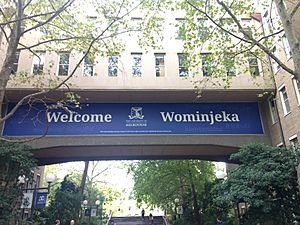Woiwurrung–Taungurung language facts for kids
Woiwurrung (also spelled Woiwurrong or Wuywurung) and Taungurung (also spelled Taungurong or Dhagung-wurrung) are Aboriginal languages from the Kulin Nation in central Victoria, Australia.
Quick facts for kids Woiwurrung–Taungurung |
||||
|---|---|---|---|---|
| Region | Victoria | |||
| Ethnicity | Woiwurrung, Wurundjeri, Taungurung, ?Ngurelban, etc. | |||
| Language family | ||||
| Dialects |
Woiwurrung
Taungurung
|
|||
| AIATSIS | S36, S37 | |||

The five Kulin nations. Woiwurrung proper is in yellow, Taungurung is in the northeast in green.
|
||||
|
||||
The Woiwurrung language was spoken by the Woiwurrung people and related groups. They lived near the Yarra River (which they called Birrarung). The Taungurung language was spoken by the Taungurung people. They lived north of the Great Dividing Range, in the Goulburn River Valley. This area includes towns like Mansfield, Benalla, and Heathcote.
Even though they are often called different languages, Woiwurrung and Taungurung were very similar. People who spoke one could usually understand the other. This means they were "mutually intelligible." Another language, Ngurai-illamwurrung, might have been a clan name, a dialect, or a closely related language.
Contents
Sounds of the Language
The Woiwurrung language has a set of sounds, including different types of consonants and vowels. The vowels are similar to English: /a/, /e/, /i/, /o/, and /u/.
Words for People (Pronouns)
In Woiwurrung, words like "I," "you," "he," and "she" are called pronouns. These languages do not use different words for "he" or "she" based on gender.
Here are some examples of Woiwurrung pronouns:
| Person | Woiwurrung (Singular) | English (Singular) | Woiwurrung (Dual - two people) | English (Dual - two people) | Woiwurrung (Plural - many people) | English (Plural - many people) | |
|---|---|---|---|---|---|---|---|
| 1st Person (Me) | Wan | I | Wangan | We two (not including you) | Wanganyinyu | We (not including you) | |
| 1st Person (Me & You) | Wangal | We two (including you) | Wanganyin | We (including you) | |||
| 2nd Person (You) | Warr | You | Wabul | You two | Wat gurrabil Wat gurrabilla Wat balak Wat wurdundhu |
You (many) | |
| 3rd Person (He/She/It) | Munyi | He/She/It | Munyi gurrabil | Those two | Malu gurrabila | They | |
Other Interesting Words
- biik = land or country.
- boorondara = shade, darkness, or night. This word is the origin of the name for the City of Boroondara in Victoria.
- nyilum biik = poor soil or hard land. This is where the name of Nillumbik Shire comes from.
- wominjeka = hello or welcome. This word is made up of parts: womin (come), je (asking to come), and ka (purpose).
- yabber = to talk. This word is now used in informal English with the same meaning.
- yarra = flowing (it also means "hair"). The Yarra River was originally called Birrarung in Woiwurrung. Early settlers might have misunderstood a boy who said "it is flowing" when asked the river's name.
Counting and Sign Language
The Wurundjeri clans used a special numbering and sign system. This was important when messengers were sent to tell nearby clans about upcoming events. These events could be ceremonies, dances (corroborees), challenges to fight, or traditional ball games like Marn Grook.
Messengers carried a message stick with marks. These marks showed how many people were involved and what kind of people they were. They also carried an object to show the type of event, like a ball for a Marn Grook game. The meeting place was spoken, but clans might not speak the same language. So, a sign language was used to show how many days until the event.
Numbers were shown by pointing to different parts of the body, from 1 to 16. After 16, which was the top of the head, the count continued on the other side of the body.
| Number | Spoken Word | Body Sign | Meaning of the Sign |
|---|---|---|---|
| 1 | bubupi-muningya | little finger | child of the hand |
| 2 | bulato-ravel | third finger | little larger |
| 3 | bulato | middle finger | larger |
| 4 | urnung-meluk | forefinger | urnung means a direction, meluk means a large grub found in some eucalyptus trees |
| 5 | babungyi-muningya | thumb | the mother of the hand |
| 6 | krauel | wrist-joint | |
| 7 | ngurumbul | the divergence of the radial tendons | a fork |
| 8 | jeraubil | the swelling of the radial muscles | |
| 9 | thambur | the inside of the elbow-joint | a round place |
| 10 | berbert | biceps | the ringtail possum, also the name of an armlet made from possum fur worn on the bicep during celebrations |
| 11 | wulung | shoulder-joint | |
| 12 | krakerap | the collar-bone | the place where a bag hangs by its strap |
| 13 | gurnbert | the neck | reed necklace, or where a reed necklace is worn |
| 14 | kurnagor | the lobe of the ear | the point or end of a hill, or a ridge |
| 15 | ngarabul | the side of the skull | a range or the ridge of a hill |
| 16 | bundial | top of the head | the cutting-place, where a mourner might cut themselves with a sharp tool (from budagra meaning to cut) |
| 17+ | After reaching the top of the head, the count continues on the same body parts on the other side of the body. So, 17 would be the other side of the skull. | ||
See also
 In Spanish: Idioma woiwurrung para niños
In Spanish: Idioma woiwurrung para niños
Images for kids



